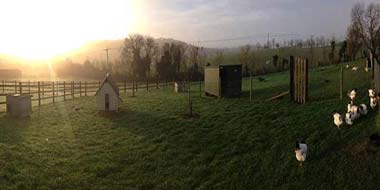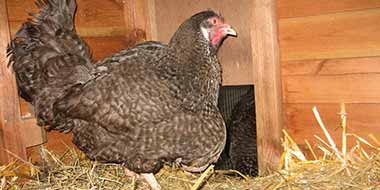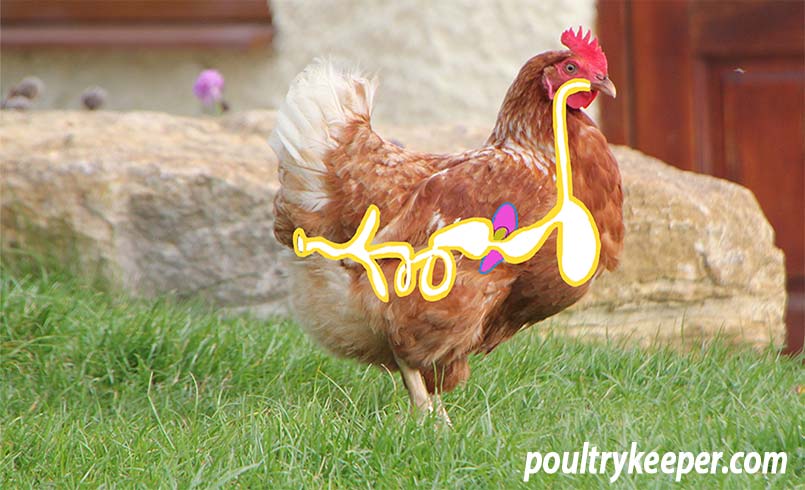
Digestive
System
Chickens are well-equipped to collect and store food in their crops for later, but hens don’t have teeth, so how do they break down and digest this food?
In this article, you will learn about the chicken’s digestive system and what to expect from your chickens during normal feeding and digestion. I finish off with some tips on things that newcomers may confuse with digestive problems.
It is helpful to understand how the digestive system of a chicken works before we start reading about digestive system problems.
We need to identify signs of normal feeding and digestion– such as a bulging crop after a chicken has stuffed itself with grain or the light brown caecal discharge (often confused with diarrhoea and expelled only once every 24 hours) so that we can then tune in to unusual feeding or digestive behaviour which can indicate problems in the digestive system of a chicken.
The digestive system of a chicken mechanically and chemically breaks down food in different stages and allows nutrients to be absorbed readily for use in the body. It starts at the beak and ends at the vent (or Cloaca to give it its proper name).
As rare as hens teeth
Despite the popular saying, of course, they don’t have teeth, they have a beak instead, but that’s only the beginning. We don’t usually think of the beak as the digestive system of a chicken; however, as well as collecting food, the beak breaks food down into course pieces that are small enough to swallow, so it’s really the first step to prepare it for the digestive system.
As we all know, the beak is used to pick up grains, insects, and vegetable material. It is quite powerful, and you will see this if you feed a chicken some grain in the palm of your hand; you will be surprised at how uncomfortable the peck can be, even though it’s trying to eat the grain rather than your hand! The beak allows the chicken to rip and tear at food with several short, sharp pecks (if necessary) to break their food down into smaller pieces.
Once the food is swallowed, it travels into the digestive system, and to understand that, you’ll need to look at my simplified diagram of a chicken’s digestive system below.
Simplified digestive system of a chicken
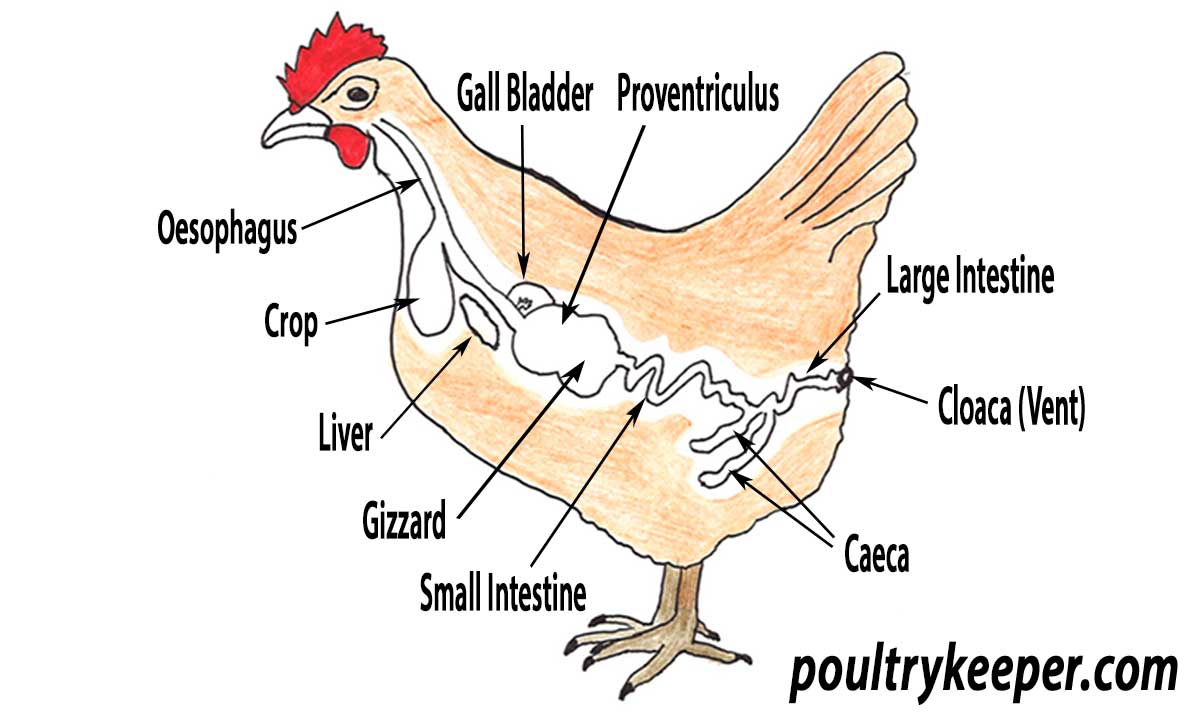
If you would like to use this diagram elsewhere, you can, but please credit this page (with a link if it’s a website) and leave the entire image intact so that poultrykeeper.com is visible. Thanks!
Basic functions of the digestive system
The basic function of the digestive system of a chicken is described here:
- The beak moistens food with Saliva. Food is not chewed, but large pieces of food are torn into smaller pieces.
- The oesophagus takes the food down to the crop to be stored. After a chicken has eaten, the crop will feel full and bulge.
- Food from the crop slowly passes down to the proventriculus.
- The proventriculus mixes the food with acids and digestive enzymes.
- Food is then passed through to the gizzard where insoluble (flint) grit has accumulated.
- Food is ground down by strong muscular action in the gizzard.
- From the gizzard, food is passed through to the small intestine and is reduced further with enzymes from the pancreas.
- Bile produced by the liver and stored in the gall bladder helps to break down fat.
- The intestines digest the food, taking nutrients from it.
- Water and the remaining undigested food is absorbed in the large intestine.
- The caeca are a pair of tubes that allow fermentation of undigested food to take place. They are emptied every 24 hours or so, and we can see this as a light brown (mustard colour) dropping that is often covered with froth.
- The cloaca/vent passes a combination of faeces and urine called semi-solid urates, together with eggs from the oviduct.
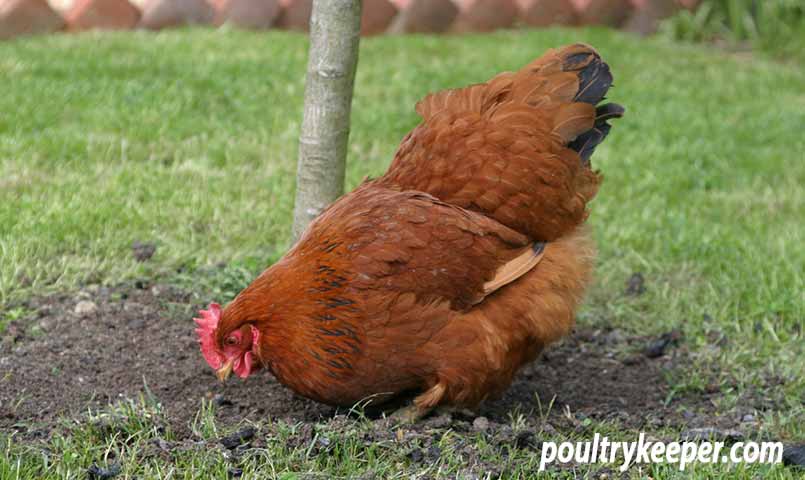
Chicken droppings
My ‘non-chicken friends’ rib me for writing about chicken droppings- I won’t repeat what they say to me! If you keep chickens, as a good owner, you will soon start to observe their interesting behaviours and their droppings, because these are often the first sign of something being wrong.
All birds, including chickens, excrete semi-solid urates. That means they have no bladder to store urine. A dropping consists of both firm brown faeces and white urates.
The colour and consistency of chicken droppings can vary according to the quantity of fluid they drink and the type of food they are eating, so once you gain some experience of what ‘normal’ looks like (there are some examples in Diarrhoea in Backyard Chickens) you can soon start to spot problems when something changes.
Symptoms sometimes confused for illness
The main problems that we encounter as hobby poultry keepers with our chicken’s digestive system are diarrhoea, internal parasites (worms) and crop problems such as an impacted (blocked) crop or sour crop.
There are, however, some normal digestive system function symptoms that we need to be aware of because these can often be confused for illness in our hens by newcomers.
1. Caecel discharge
I can remember wondering why my chickens had horrible mustard colour diarrhoea from time to time. It was quite a few years later, after reading some veterinary books on diseases of poultry, that I discovered that, in fact, it was perfectly normal for a hen to have a wet, frothy, mustard coloured dropping.
The caeca tubes are emptied, causing this to take place approximately every 24 hours or about 1 in every 10 droppings, and it is perfectly normal in healthy hens.
2. Wet droppings during hot weather
Chickens cannot sweat, so they can only cool down during warm weather by panting and drinking more water. As a result, you may find your flock is producing more wet droppings during warmer weather.
Water for poultry is massively under-rated. It is vital hens drink to hydrate during hot weather, but also water intake increases by up to 70% when a hen is laying because two-thirds of an egg is made up of water.
You can help your chickens by giving them some cool, fresh water on hot days and placing their water container out of the sun, so it doesn’t overheat.
- If you are concerned about your chicken’s droppings, then you might like to read Poultry Vet Richard Jackson’s article on Diarrhoea in Backyard Chickens.
3. Bulging crop
In the wild, chickens are vulnerable to predation, so when they find a source of food in abundance, they can collect it quickly with their beaks and store it in their crops to digest later without spending too long hanging around to get eaten!
If chickens are hungry or are given treats such as mixed corn (scratch if you’re in the US), they will make the most of it and fill their crops as much as they can.
Finding a hen with a huge crop often makes us think of problems such as an impacted/blocked crop. If you are concerned, wait overnight and check your hen in the morning to see if the crop has emptied. Of course, you will need to check her before she has her breakfast!
- For some more tips about other aspects of chicken’s health, you might like to read Jeremy’s article Avoiding Problems when Keeping Chickens.

